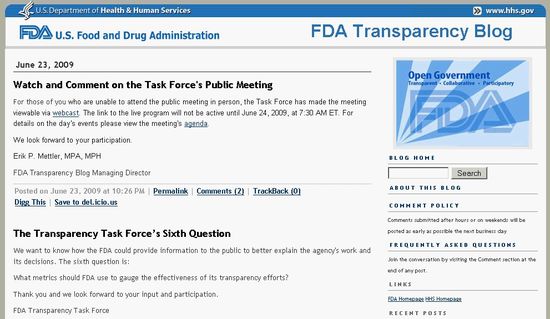Several weeks ago, what some might consider the most unlikely government agency to embrace social media decided to launch a blog. The FDA Transparency Blog was aimed at bringing a level of transparency to an agency that its own leader FDA Commissioner Margaret Hamburg recently described as a “black box that makes important decisions without explaining them.” Central to this effort for transparency was the creation of a “task force” of individuals that would examine the inner workings of the agency and provide recommendations on how to make it more transparent by the end of this year (2009).
To do this, they have posed 6 big questions:
- How can the agency better explain its operations, activities, processes and decision making?
- What specific information should FDA provide about agency operations, activities, processes, and decision making, including enforcement actions, product approvals, recalls and other actions?
- What tools, techniques, processes, or other mechanisms should FDA use to be more effective in providing useful and understandable information?
- What, if any, legislative or regulatory changes are needed to improve FDA’s ability to provide useful and understandable information to the public?
- As FDA becomes more transparent, what information should remain confidential in order to promote key internal and external policy goals, such as preserving patient privacy, and how, in these cases, should FDA explain the importance of confidentiality?
- What metrics should FDA use to gauge the effectiveness of its transparency efforts?
Yesterday, this task force had their first public meeting to start to gather input to answer these questions. The meeting was open to any member of the public, and was live webcast over the Internet as well. I watched some (not all) of the proceedings to prepare for this post. The topics in conversation ranged from how the FDA should release information to ideas on how to improve their website by segmenting it into very defined consumer and industry focused areas.
As you might expect, several of the participants on the speaking roster had a very definite bone to pick with the FDA. From an irate ousted doctor to several underappreciated public interest groups – many of the 5 minute panel segments seemed less constructive then therapeutic … helping individuals who have felt silenced for too long to have a stage to share their emotions.
Yet this combination of the passionate neglected with the involved optimists was part of the beauty of the entire meeting. Ultimately, in my opinion there were three key factors that made this meeting a big success for the FDA:
- Asking big questions. If you look at the questions copied earlier in this post, you’ll agree that none have overnight solutions. They are tackling big issues at a big agency during a big time of change in the healthcare world instead of taking the easier and more traditional government entity approach of implementing smaller more watered down initiatives.
- Listening without getting defensive. The variety of opinions shared in the public meeting and through comments on their blog is wide, however they are demonstrating a willingness to listen that many are unaccustomed to receiving from the FDA. Most importantly, they heard the criticisms from yesterday (for the most part) without feeling the need to get defensive or justify things they are currently doing.
- Demonstrating a desire for help. On more than one occasion during the session members of the task force asked for opinions, guidance and help from those presenting. It was a telling moment that will likely do more than anything to reduce the perception of the FDA as a closed organization. If they can effectively use all these partners willing to help and create stronger ties with their immediate community – they will leap ahead in terms of becoming more open.
The first step in transparency is a willingness to stand in front of your detractors, listen to their problems, and show your commitment to improving. The day after this first public forum meeting, it is tough not to feel the palpable sense of hope that anyone who watched or listened should feel about the future of the FDA. As the world continues to evolve thanks to social media, virtual relationships and real time communication at least one government agency seems determined not to be left behind. And if the FDA can do it, any organization can.
This post was originally posted on the 360 Digital Influence blog.







WE RECENTLY REMOVED COMMENTING - LEARN WHY HERE >